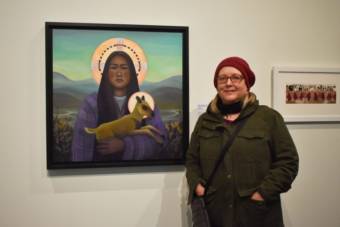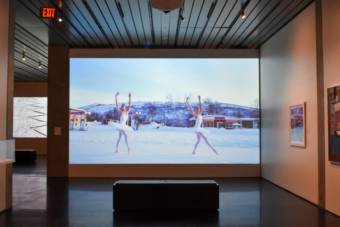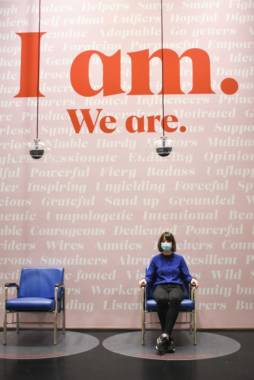
The Anchorage Museum launched a new exhibit this month celebrating the contributions, legacies and strength of women from the circumpolar north. “Extra Tough: Women of the North” gathers artwork from women from Alaska, Canada, Iceland, Finland and Russia to explore their often untold histories.
Resilience is a common theme throughout the “Extra Tough” exhibit.
“I come from a long line of very strong women,” said Linda Infante Lyons, an Alutiiq artist, standing in front of a portrait she painted of Ahtna artist Melissa Shaginoff.
Lyons’ mother’s family is from the village of Karluk on Kodiak Island, survivors of centuries of colonization that started with the Russian fur trade.
“The story of how the women held things together while many of the men were taken off as basically slaves to do the work for the colonizing forces, I think is an important one,” she said.
In the portrait behind her, Shaginoff is posed like the Madonna, dressed in work clothes and holding a baby caribou, a symbol of her clan. Shaginoff’s forward gaze is confident and empowered, the face of a resilient survivor.

For centuries, the histories of the circumpolar north have been written primarily by men. “Extra Tough: Women of the North” seeks to widen that lens with the personal stories, objects, portraits, films and audio diaries of women and nonbinary people from all around the far North.
“Part of the goal of that, too,” said Francesca DuBrock, chief curator at the Anchorage Museum, “is to really highlight the value of all of these held stories, because it’s not that the knowledge doesn’t exist, or that these people never existed, it’s just that it didn’t make it into a book. And that’s really a very narrow way of assessing knowledge and value in our culture.”
DuBrock and her team worked for a year to put “Extra Tough” together, trying to bridge those gaps in recorded history. Throughout the exhibit, artists tell their own stories on themes like gender as a social construct, the objectification of women’s bodies and the exploitation of Northern lands.
“There is a really strong corollary in a lot of the works between the autonomy of the human body — and particularly a woman’s body — and the autonomy of the land,” said DuBrock.
Photographs from the Icelandic artist Rúrí depict waterfalls that disappeared after two rivers were dammed for a hydroelectric project.
“it’s really a memorial to these waterfalls, which she sees as entities with their own rights for being,” DuBrock said.

A film by Finnish-Sámi artist Marja Helander follows twin Sámi ballerinas dancing across their ancestral lands to the steps of the Finnish parliament. It’s a commentary on the political struggles of indigenous Sámi people to reclaim their land.
In one section dedicated to the labor and individual contributions of women in Alaska, DuBrock pointed out a 1920’s photograph of a young Iñupiat woman, Ada Blackjack, who was on a failed expedition to Wrangel Island.
“She was the only woman and the only indigenous person on this mission. And all of the men perished. And she survived for a full year in the High Arctic, and was eventually rescued. But she is a pretty amazing story of resilience and courage.”

In another area, bowl-shaped speakers hang over “affirmation chairs” — loosely designed to feel like you’re at the hairdresser. Recordings of contemporary Alaskan women and nonbinary people sharing their stories and wisdom play over the speakers.
One woman speaks about the privilege of voting, another talks about walking off the beaten path. “It takes courage to be a trailblazer, to make your own trails, and follow your own music,” she says. “But if you trust yourself, you cannot get lost.”
DuBrock said they’re still looking for stories of more Northern women to include, particularly immigrants and Black women, “because so many of their stories have not made it into the official record,” she said.
“So many of these stories, I think, are still in family photo albums. It’s a great and appropriate place for those stories to live, but we’d also love to share them more broadly, if people would like to tell them.”
“Extra Tough: Women of the North” is on display now until September. The Anchorage Museum is open Wednesday through Saturday from 10 a.m. to 6 p.m. Masks and social distancing are required.
